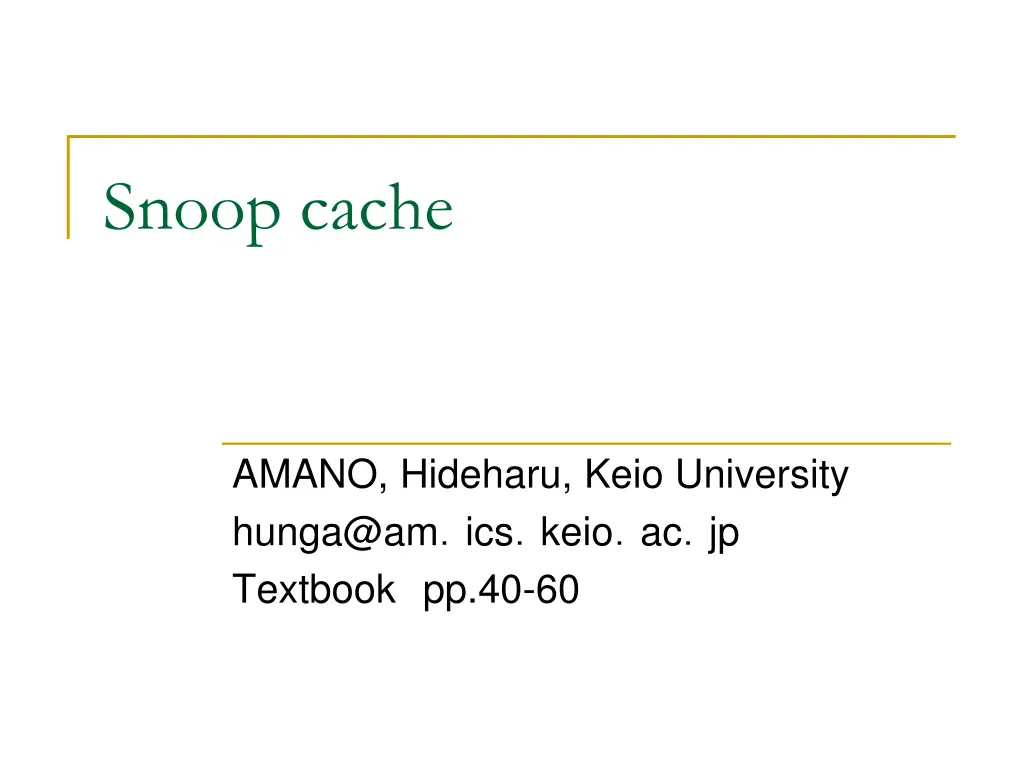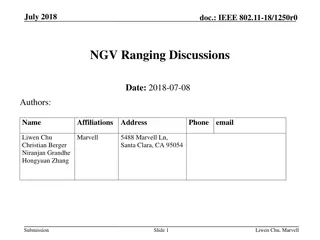
Understanding Cache Memory Organization in Computer Systems
Delve into the intricacies of cache memory in computer systems, from the basics of cache memory to controlling cache mapping and various cache access scenarios involving direct mapping, conflict misses, set-associative mapping, and write-through operations.
Download Presentation

Please find below an Image/Link to download the presentation.
The content on the website is provided AS IS for your information and personal use only. It may not be sold, licensed, or shared on other websites without obtaining consent from the author. If you encounter any issues during the download, it is possible that the publisher has removed the file from their server.
You are allowed to download the files provided on this website for personal or commercial use, subject to the condition that they are used lawfully. All files are the property of their respective owners.
The content on the website is provided AS IS for your information and personal use only. It may not be sold, licensed, or shared on other websites without obtaining consent from the author.
E N D
Presentation Transcript
Snoop cache AMANO, Hideharu, Keio University hunga@am ics keio ac jp Textbook pp.40-60
Cache memory A small high speed memory for storing frequently accessed data/instructions. Essential for recent microprocessors. Basis knowledge for uni-processor s cache is reviewed first.
CPU Transparent from Software Memory Hierarchy Locality is used. On-Chip cache 64KB 1-2clock L1 Cache Small high speed 256KB 3-10clock L2 Cache 2M 4MB 10-20clock L3 Cache SRAM Large low speed Main memory DRAM 4 16GB 50-100clock Managed by Operating System Secondary Memory -msec TB
Controlling cache Mapping direct map n-way set associative map full-map Write policy write through write back Replace policy LRU(Least Recently Used)
Direct Map From CPU 0011010 0011 010 100 Main Memory (1KB=128blocks) 010 Yes Hit Data = 010 0011 Cache (64B=8blocks) Cache Directory (Tag Memory) 8 entries X (4bit ) Simple Directory structure
Direct Map (Conflict Miss) From CPU 0000010 0000 010 100 Main Memory 010 No: Miss Hit = 010 0011 0000 Cache Conflict Miss occurs between two blocks with the same index Cache Directory (Tag Memory)
2-way set associative Map From CPU 0011010 00110 10 100 Main Memory (1KB=128blocks) 10 Yes: Hit Data = 10 00110 Cache (64B=8blocks) No = 00000 Cache Directory (Tag Memory) 4 entries X 5bit X 2
2-way set associative Map From CPU 0000010 0011010 00000 10 100 10 Main Memory (1KB=128 blocks) No = 10 00110 Cache (64B=8 blocks) Yes: Hit Data = 00000 Cache Directory (Tag Memory) 4 entries X 5bit X 2 Conflict Miss is reduced
Write Through Hit 0011010 From CPU Main Memory (1KB=128 blocks) 0011 010 100 The main memory is updated 0011 Hit Cache (64B=8 blocks) Write Data Cache Directory (Tag Memory) 8 entries X (4bit )
Write Through MissWrite non-allocate(Direct write) ) 0000010 0011010 From CPU Main Memory (1KB=128 blocks) 0000 010 100 Only main memory is updated 0011 Miss Cache (64B=8 blocks) Write Data Cache Directory (Tag Memory) 8 entries X (4bit )
Write Through MissWrite allocate(Fetch-on- write) ) 0000010 0011010 From CPU Main Memory (1KB=128 blocks) 0000 010 100 0011 0000 Miss Cache (64B=8 blocks) Write Data Cache Directory (Tag Memory) 8 entries X (4bit )
Write Through MissWrite allocate(Fetch-on- write) ) 0000010 0011010 From CPU Main Memory (1KB=128 blocks) 0000 010 100 0011 0000 Miss Cache (64B=8 blocks) Write Data Cache Directory (Tag Memory) 8 entries X (4bit )
Write Back Hit 0011010 From CPU Main Memory (1KB=128 blocks) 0011 010 100 Dirty 1 0 0011 Hit Cache (64B=8 blocks) Write Data Cache Directory (Tag Memory) 8 entries X (4bit+1bit )
Write Back Replace 0000010 0011010 From CPU Main Memory (1KB=128 blocks) Write Back 0000 010 100 Dirty 0011 1 Miss Cache (64B=8 blocks) Cache Directory (Tag Memory) 8 entries X (4bit+1bit )
Write Back Replace 0000010 0011010 From CPU Main Memory (1KB=128 blocks) 0000 010 100 Replace Clean 0011 0000 0 Cache (64B=8 blocks) Cache Directory (Tag Memory) 8 entries X (4bit+1bit )
Shared memory connected to the bus Cache is required Shared cache Often difficult to implement even in on-chip multiprocessors Private cache Consistency problem Snoop cache
Shared Cache 1 port shared cache Severe access conflict 4-port shared cache A large multi-port memory is hard to implement PE PE PE PE Shared Cache Bus Interface Shared cache is often used for L2 cache of on-chip multiprocessors Main Memory
Snoop Cache Main Memory (L2 Cache) A large bandwidth shared bus Snoop Cache Snoop Cache Snoop Cache Snoop Cache PU PU PU PU Each PU provides its own private cache
Implementation of buses Passive Bus Board level implementation Active Bus: Chip level implementation Multiplexer A single module sends data to all other modules
Synchronous bus is suitable for block transfer Clock Strobe Address/ Data Acknowledge The start/end handshake is the same, but block transfer is possible synchronized with a clock
Bus as a broadcast media A single module can send (write) data to the media All modules can receive (read) the same data Broadcasting Tree Crossbar + Bus Network on Chip (NoC) Here, I show as a shape of classic bus but remember that it is just a logical image.
Cache coherence problem Main Memory (L2 Cache) A large bandwidth shared bus A A PU PU PU PU The same block is cached in two cache modules
Cache coherence (consistency) problem Main Memory (L2 Cache) A large bandwidth shared bus A A A PU PU PU PU Data in each cache is not the same
Coherence vs. Consistency Coherence and consistency are complementary Coherence defines the behavior of reads and writes to the same memory location, while Consistency defines the behavior of reads and writes with respect to accesses to other memory location. Hennessy & Patterson Computer Architecture the 5thedition pp.353
Cache Consistency Protocol Each cache keeps consistency by monitoring (snooping) bus transactions. Write Through Every written data updates the shared memory. Frequent access of bus will degrade performance Basis Synapse) Ilinois Berkeley Firefly Dragon Invalidate Write Back: Update (Broadcast)
Glossary 1 Shared Cache: Private Cache: Snoop Cache: Snoop ( Coherent Consistency) Problem: PE Coherent Cache Conherence Consistency Direct map: n-way set associative: Write through, Write back: Write through Direct Write Fetch on Write Dirty/Clean: /
Invalidation type Data read out Invalidated Valid Main Memory (L2 Cache) A large bandwidth shared bus PU PU PU PU
Invalidate type Data write into Invalidate Valid Main Memory (L2 Cache) A large bandwidth shared bus Monitoring (Snooping) I PU PU PU PU
Invalidate type Write-non-allocate) The target cache block is not existing in the cache Invalidated Valid Main Memory A large bandwidth shared bus Monitoring (Snooping) V I PU PU PU PU
Invalidate type Write-allocate) Cache block is not existing in the target cache Invalidated Valid Main Memory A large bandwidth shared bus PU PU PU PU
Invalidate type Write-allocate) Invalidated Valid Main Memory First, Fetch A large bandwidth shared bus PU PU PU PU Fetch and write
Invalidate type Write-allocate) Invalidated Valid Main Memory A large bandwidth shared bus Monitoring (Snoop) PU PU PU PU Fetch and write
Update type Invalidated Valid Main Memory A large bandwidth shared bus Monitoring (Snoop) V Data is updated PU PU PU PU
The structure of Snoop cache Shared bus Directory can be accessed simultaneously from both sides. Directory The bus transaction can be checked without caring the access from CPU. Cache Memory Entity The same Directory (Dual Port) Directory CPU
Quiz Following accesses are done sequentially into the same cache block of Write through Write non- allocate protocol. How the state of each cache block is changed ? PU A: Read PU B: Read PU A: Write PU B: Read PU B: Write PU A: Write
Answer A V V V V I I B V I V V V PU A: Read PU B: Read PU A: Write PU B: Read PU B: Write PU A: Write
The Problem of Write Through Cache In uniprocessors, the performance of the write through cache with well designed write buffers is comparable to that of write back cache. However, in bus connected multiprocessors, the write through cache has a problem of bus congestion.
Basic Protocol States attached to each block C Clean (Consistent to shared memory) D: Dirty I Invalidate Main Memory A large bandwidth shared bus C C Read Read PU PU PU PU
Basic ProtocolA PU writes the data Main Memory A large bandwidth shared bus Invalidation signal D I C C Write PU PU PU PU Invalidation signal: address only transaction
Basic Protocol (A PU reads out) Main Memory Read request A large bandwidth shared bus Snoop D I Read PU PU PU PU
Basic Protocol (A PU reads out) Main Memory A large bandwidth shared bus D C C Read PU PU PU PU
Basic Protocol (A PU writes into again) Main Memory Write request A large bandwidth shared bus Snoop Snoop Cache Snoop Cache D I W PU PU PU PU
Basic Protocol (A PU writes into again) Main Memory A large bandwidth shared bus D I D W PU PU PU PU
State Transition Diagram of the Basic Protocol write miss for the block write I I write miss Write back & Replace Replace read Replace D write hit write miss Replace Invalidate Invalidate read miss for the block D C C read miss Write back & Replace read miss Replace Bus snoop request CPU request
States for each block Illinois s Protocol(MESI) CE Clean Exclusive CS Clean Sharable DE Dirty Exclusive I Invalidate Main Memory A large bandwidth shared bus CE Snoop Cache Snoop Cache PU PU PU PU The first PU reads
States for each block Illinois s Protocol CE Clean Exclusive CS Clean Sharable DE Dirty Exclusive I Invalidate Main Memory A large bandwidth shared bus Snoop Snoop CE CS Snoop Cache Snoop Cache CS PU PU PU PU The second PU reads
Illinoiss Protocol (The role of CE) CE Clean Exclusive CS Clean Sharable DE Dirty Exclusive I Invalidate Main Memory A large bandwidth shared bus CE Snoop Cache Snoop Cache Snoop Cache DE W PU PU PU PU CE is changed into DE without using the bus
Berkeleys protocol (MOSI) Main Memory A large bandwidth shared bus Snoop Cache Snoop Cache US R PU PU PU PU Ownership responsibility of write back OS:Owned Sharable OE:Owned Exclusive US:Unowned Sharable I Invalidated
Berkeleys protocol (MOSI protocol) Main Memory A large bandwidth shared bus Snoop Cache Snoop Cache US US R PU PU PU PU Ownership responsibility of write back OS:Owned Sharable OE:Owned Exclusive US:Unowned Sharable I Invalidated
Berkeleys protocol (A PU writes into) Main Memory A large bandwidth shared bus snoop Snoop Cache Snoop Cache US OE US I W PU PU PU PU Invalidation is done like the basic protocol



